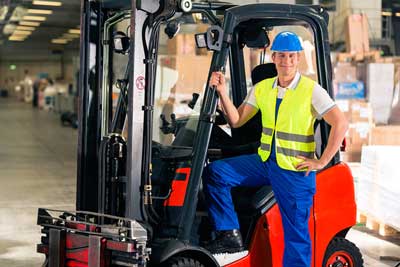The Essential Guide to Forklift Safety
Forklifts are incredibly useful across any number of industries, from order pickers to diesel-powered cargo loaders to simple pallet jacks. But like any industrial machine, they can be misused, and accidents happen. Before anybody takes a seat and turns the key, here's the essential guide to forklift safety.
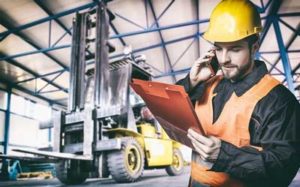
Why Are Forklifts Dangerous?
The forklift seems fairly innocuous, and if you've used one, you might wonder just what the big deal is. Take it slow, lift carefully, and you'll be accident-free, or at least that's how the belief goes. Unfortunately, physics has a tendency to disagree.
The most common accident with any forklift is tipping over. As they're designed to fetch heavy weights from large heights, the center of gravity on a forklift is constantly shifting, and an unaware operator can push the forklift too far and put both themselves and their fellow employees in danger. In addition, the fork can crack pallets, spilling cargo from heights that may potentially injure other employees, and poorly seated cargo can slip off the fork, creating a falling hazard.
Add to this the multitude of accidents that can be common in any workplace. Slips and falls off a step into the cab, head injuries on low forks or cab roofs, and injuries from the fork itself are commonplace. Nor is moving the forklift, with or without cargo, risk free. Skidding out on slippery surfaces, backing into people behind you, taking a turn too quickly and tipping over, driving too fast and being tipped over by the momentum of the load, and even getting struck yourself by parking your forklift in the wrong place are equally common hazards. So, how do you operate a forklift safely?
Safety Gear
To begin, no one should be on a forklift without the appropriate workplace safety attire. Sturdy non-slip work boots and work pants should be worn. Work gloves with grip textures, especially when handling sensitive or dangerous cargo, should also be worn when necessary. Hard hats should be mandatory whenever the forklift is in operation, by both the operator and anyone who may be working near the forklift as it operates. Eye protection should be issued where appropriate. The foreman needs to check every employee for safety gear, not allowing any improperly dressed person on the forklift or on the floor while the forklift is operating.
Most forklifts come with seat belts, and they should be worn whenever an operator is at the wheel, even if the forklift is not in motion. All forklifts should also have a set of blocks available, especially if they will have to go up, or park, on inclines.
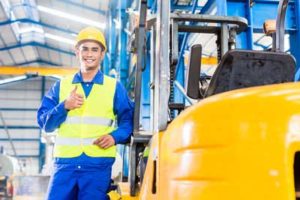
Pre-Use Inspection
Perform a pre-use inspection before starting up your forklift. Check to ensure that the floor you're on and the step up to the cab is free of water, oil, and other substances that might make it slippery. If you find anything, clear it away as much as possible before using the forklift. Remove any obstructions to visibility, such as dirt on mirrors or blockages that won't let you see out the back of the cab. If the forklift has tires, inspect them for deflation, oil slicks, and other potential problems. Make sure that the forklift brakes are set and blocked. Disconnect it from any power or fuel sources before operating. Examine the fork itself for foreign substances, forgotten tools, and other potential safety hazards.
Once it's safe to turn on the forklift, climb into the cab. You should never jump on or off a forklift, but step into it using the provided step and seat. Seat yourself, buckle your safety belt, turn the key and ensure everything is operating properly. Make sure the fork is at its lowest position before driving the forklift away. If you have any suspicion the forklift may be malfunctioning, report it immediately and don't use it until it's been cleared by a mechanic for use.
Driving
The rules of the road apply to the forklift as much as other construction equipment, or even your car. First, do not speed, with or without cargo on the forklift. Speeding puts your coworkers and you at risk, and makes a tip over more likely if you take turns too quickly or are forced to brake suddenly. With cargo on the fork, take your time and drive at an appropriate speed. Many forklifts have a simple speedometer you should keep an eye on. If one is not available, assume half-speed or slower is the best, to err on the side of caution.
Similarly, do not take turns quickly, and assume that any turn where you don't have a clear line of sight is a blocked one. Never operate a forklift "blind" and check in all directions while driving. When backing up, look behind you, and when turning, look where you're taking the forklift. Be sure that the proper warning devices are fully operational before driving. Use verbal signals and the horn, if available, with coworkers to ensure a clear path. If a floor is wet or otherwise slippery, drive more slowly and be aware of skidding.
Obey all signals of the road, even if you're in a warehouse. If you see a stop sign is posted, for example, obey it. This is especially important for protecting pedestrians. Finally, drive your forklift only in appropriate environments. If it's not rated or designed for rugged terrain, do not attempt to take it on such.
When parking a forklift, always park it on a hard, flat surface where possible, and choose a location out of the way of other traffic and vehicles. If parking on a flat surface isn't possible, make sure the back wheels are blocked and your parking brake is carefully set. If you have cargo, make sure the load is as low as possible, preferably touching the floor.
Finally, where necessary, use headlights. Low lighting can be just as dangerous as high speeds in the right circumstances. Be sure to use forklifts in properly lit environments and if lighting is insufficient, work out how to properly light the area.
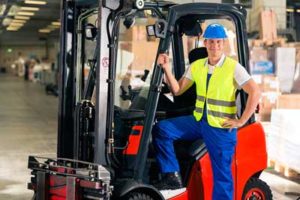
Removing And Transporting Cargo
Before lifting or lowering the fork, check that there are no obstructions above or below you. Never allow a coworker to step under the fork while it is in use. Raise the fork slowly and check that you're level with the pallet or other material before you move the fork forward.
Remember that the best warning system is your ears. If you hear a pallet crack, cargo shift when it shouldn't move, or any other sign something might have gone wrong, verbally warn anyone away from the area. Slowly remove the fork, checking behind and in front for coworkers and falling cargo. Report the situation to a foreman.
When the cargo is properly seated on the fork, back away slowly, checking behind you at all times, and verbally warn anyone nearby as necessary. Once the cargo and fork are clear, slowly lower the cargo until the fork is at its driving position. Quickly lowering the fork can cause a tip over, and you should never drive the forklift with elevated cargo. Even if the fork is only slightly extended, it can block your field of view and change the center of gravity on the forklift. Once the cargo is low enough and you're satisfied you'll be able to drive the forklift safety, you can go on your way.
Tip Overs
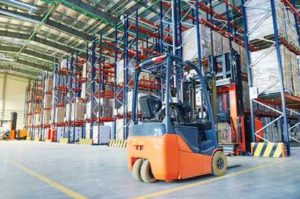
While the goal is to prevent tip overs and accidents on a forklift, they can happen even with the most well-trained operators. Before you drive a forklift, be aware of the proper procedure during a tip over.
First, do not attempt to jump clear of the forklift from the cab. This will only put you at risk for injury, either by pinning you under the forklift or by getting you tangled in the cab. Similarly, if you can sense a forklift about to tip over, issue a verbal warning.
As the forklift tips, follow this procedure. First, brace your feet against the inside of the cab. Second, hold tightly to the steering wheel. Third, lean forward towards the steering wheel and away from the point of impact. This will protect you as much as possible, especially when this procedure is combined with proper seat belt use.
Safety In The Workplace
Finally, the most common and useful tool for protecting yourself and your coworkers in the workplace is simple common sense. Often thinking ahead and sensible planning is the best way to be safe in the workplace. If something seems unsafe, or there's a potential problem you see, say something and think about how to resolve the problem. More often than not, this will be the most effective way to protect yourself and others.
Forklift safety is a matter of using common sense and proper safety procedures. Practice those, and you'll use a forklift safely, no matter what the environment. If you need a forklift, see our forklift buyer's guides.
